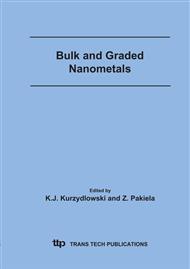p.143
p.147
p.151
p.157
p.165
p.171
p.181
p.187
p.197
Phase Transformations in Carbon Steel Powders Subjected to Ball Milling
Abstract:
The tool carbon steel powder, containing 1.1 % C, was subjected to heavy cold working by ball milling in a Fritsch P5 planetary ball mill. XRD studies showed that ball milling results in a dissolution of cementite and formation of nanoferrite. The crystallite size and lattice strain of ferrite, calculated by applying Williamson-Hall method, were 10 nm and 1%, respectively. Mössbauer spectroscopy measurements confirmed the formation of a phase called “distorted ferrite”, characterized by the values of hyperfine field of 28.5 T and isomer shift of 0.15 mm/s, different from ones of ferrite (32.9 T and 0.00 mm/s, respectively). DSC investigations revealed two heat effects recorded during heating the sample after 100 h of ball milling: exothermic effect at 360oC and endothermic one at 580oC. The first one was attributed to the dramatic decreasing of lattice strain (from 1% after milling down to 0.1%, as showed XRD studies) and slightly increasing of crystallite size (from 10 to 25 nm).The formation of Fe3C was not observed in this temperature and the structure of nanoferrite was preserved. The second observed heat effect was reversible and probably related to the eutectoid transformation, shifted by ball milling to lower temperature range, comparing to equilibrium conditions.
Info:
Periodical:
Pages:
165-170
Citation:
Online since:
January 2005
Authors:
Price:
Сopyright:
© 2005 Trans Tech Publications Ltd. All Rights Reserved
Share:
Citation:


